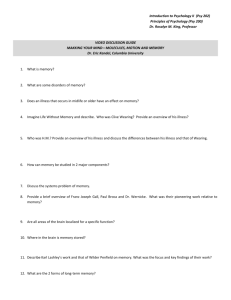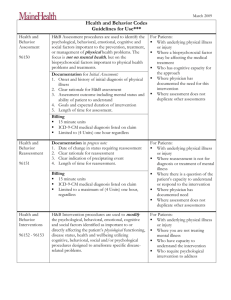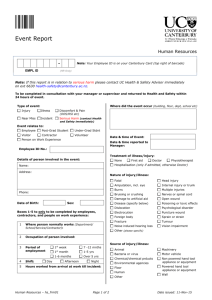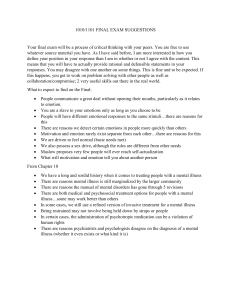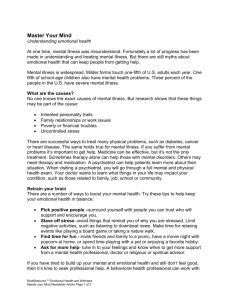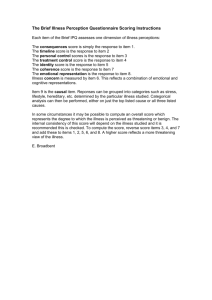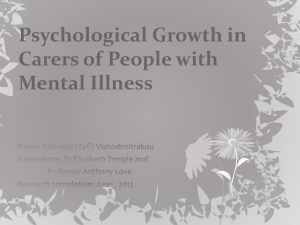the mind–body connection
advertisement
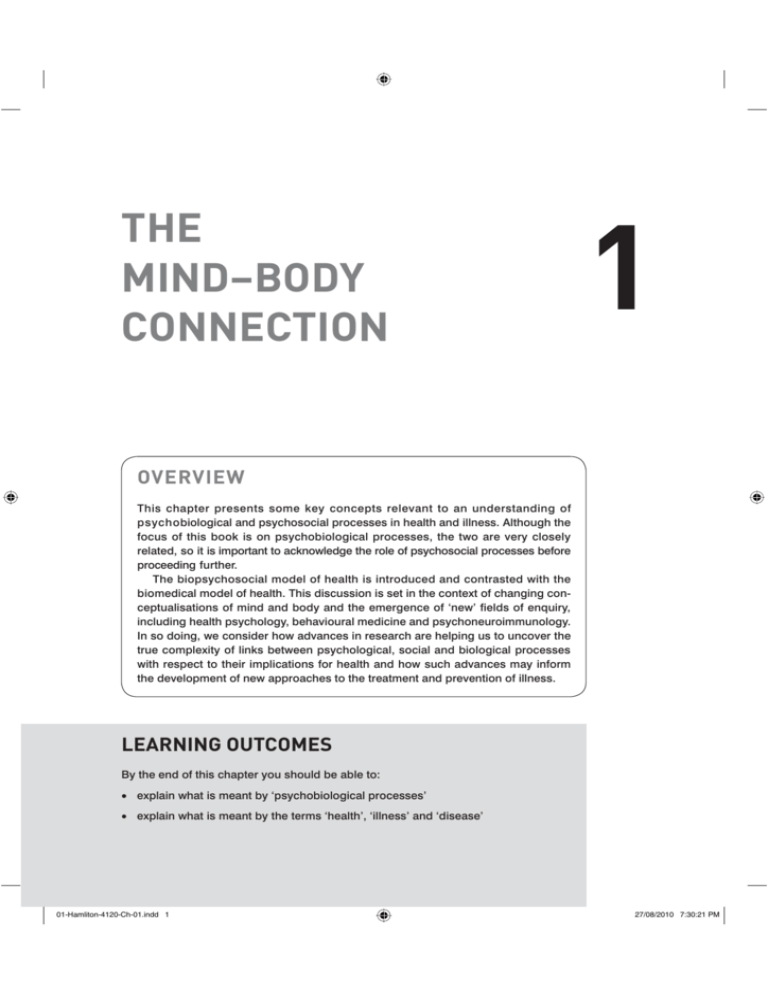
THE MIND–BODY CONNECTION 1 OVERVIEW This chapter presents some key concepts relevant to an understanding of psychobiological and psychosocial processes in health and illness. Although the focus of this book is on psychobiological processes, the two are very closely related, so it is important to acknowledge the role of psychosocial processes before proceeding further. The biopsychosocial model of health is introduced and contrasted with the biomedical model of health. This discussion is set in the context of changing conceptualisations of mind and body and the emergence of ‘new’ fields of enquiry, including health psychology, behavioural medicine and psychoneuroimmunology. In so doing, we consider how advances in research are helping us to uncover the true complexity of links between psychological, social and biological processes with respect to their implications for health and how such advances may inform the development of new approaches to the treatment and prevention of illness. LEARNING OUTCOMES By the end of this chapter you should be able to: v explain what is meant by ‘psychobiological processes’ v explain what is meant by the terms ‘health’, ‘illness’ and ‘disease’ 01-Hamliton-4120-Ch-01.indd 1 27/08/2010 7:30:21 PM 2 PSYCHOBIOLOGICAL PROCESSES IN HEALTH AND ILLNESS v explain what is meant by ‘normality’ v discuss global trends in disease, mortality rates and the causes of ill health v describe the biopsychosocial model of health and compare it with the biomedical model v discuss the influence of the biopsychosocial model on the development of new disciplines v describe and differentiate between these disciplines v describe the process of defining and measuring a psychological construct v explain why psychobiological processes are important for understanding, preventing and treating disease and illness. CHANGING CONCEPTUALISATIONS OF MIND AND BODY This book is entitled Psychobiological Processes in Health and Illness, so, before proceeding further, it is useful to begin by considering what exactly we mean by the terms ‘psychobiological’, ‘health’ and ‘illness’. While the latter two terms may seem intuitive, there has been considerable debate over the years regarding the definition of both ‘health’ and ‘illness’, and the distinction between health, illness and disease. Further, to explain the term ‘psychobiological’, we need to break the word down into its two constituent parts – ‘psycho-’ ‘and ‘biological’. In this chapter, then, we also consider why both psychological and biological processes are relevant to an understanding of health and illness and how these two types of processes have come to be combined into a single term. 1.1 1.1.1 DEFINING HEALTH, ILLNESS AND DISEASE What does it mean to be healthy? Well, we could start by considering that health indicates a lack of illness or a lack of disease – you are not ill, therefore you are healthy. This is a difficult starting point, though, since both illness and disease themselves are poorly defined (as discussed further below). Also, are you in optimum health if you are not diseased or is health something more than absence of illness? The World Health Organisation, for example, has defined health as ‘a state of complete physical, mental and social well-being and not merely the absence of disease or infirmity’ (WHO, 1946: 100). According to this definition, though, we would probably all be considered unhealthy. For example, you may not consider yourself completely healthy because you get out of breath walking up stairs or are unable to complete a marathon. At what point is our well-being less than complete? 01-Hamliton-4120-Ch-01.indd 2 27/08/2010 7:30:21 PM 3 THE MIND–BODY CONNECTION Perhaps what really matters is the individual’s ability to perform daily functions, such as continuing to go to work, raise a family or drive a car. Disease does not necessarily preclude normal daily functioning, so what about a patient with a terminal illness who is still able to go to work – is this person healthy or ill? Perhaps you could consider yourself to be a healthy person even if you are, from time to time, afflicted with a runny nose, headache or sore throat. If so, why do these symptoms not constitute a lack of health? Maybe, then, we should overlook symptoms that are highly prevalent in the population and consider whether or not the individual experiences symptoms that are abnormal. This, too, raises problems. First, how do we define ‘abnormal’ and, second, is ‘abnormal’ necessarily unhealthy? In relation to the former point, what is ‘normal’ in terms of physical, social and mental functioning depends on a wide range of factors, including the individual’s age, gender, social status and culture. In relation to the latter point, it is clear that an individual can fall outside the range of statistical normality without necessarily being ill. For example, Veatch (1981) points out that the seven foot tall basketball player is not considered ill, nor are people with freckles, although both can be considered to be statistically abnormal (see Box 1.1). BOX 1.1 Statistical normality Many human characteristics follow a normal distribution. This means that most individuals will be at or around the average value for the group (such as being the average height for a man or woman). The frequency of a particular measurement decreases as the distance from the average value increases (there are few very short or very tall people, but many people are of roughly average height). If measurements are plotted on a graph, with the measurement scale on the X axis and frequency on the Y axis, this results in a bell-shaped curve, or, ‘Gaussian function’. Individuals falling at the tail ends of the distribution are considered statistically abnormal. The cut-off value used most commonly is 95 per cent – that is, scores outside of the 95 per cent range (the top 2.5 or bottom 2.5 per cent) are abnormal. It is important however, to consider the ‘reference group’ used to calculate the normal range. For example, many people will appear abnormal if compared against norms for a different cultural group or age group or gender. Many indicators of health (such as the level of glucose or cholesterol in the blood) follow a normal distribution. Individuals with values outside the normal range (for healthy individuals) are considered abnormal, although this does not necessarily indicate that these individuals are unhealthy. Many measures of psychological characteristics (such as intelligence, aggression) yield scores that are approximately normally distributed – that is, there are lots of people of roughly average intelligence, but few individuals with exceptional genius. As with indicators of physical health, abnormal scores on psychological measures do not necessarily indicate a need for treatment. 01-Hamliton-4120-Ch-01.indd 3 27/08/2010 7:30:21 PM 4 PSYCHOBIOLOGICAL PROCESSES IN HEALTH AND ILLNESS Perhaps, then, we should consider the individual’s evaluation of his or her apparent symptoms. Are they abnormal for the individual and a source of distress or are they typical, tolerable? Thus, being unable to run a marathon could constitute evidence of ill health if the individual is normally able to run the marathon very easily and experiences distress in relation to this loss of physical fitness. Is this person really ill though, or do they simply need to adapt their training routine? It is clear, then, that although we may know in very general terms what we mean by the word ‘health’, providing a precise definition for this concept is far from straightforward. Further, it is evident that the related constructs of ‘illness’ and ‘disease’ are similarly ambiguous. Engelhardt (1981: 39) writes that ‘the concept of disease is an attempt to correlate constellations of signs and symptoms for the purposes of explanation, prediction and control’, while Boorse (1977) proposes that a disease is only an ‘illness’ if it is serious enough to be incapacitating and therefore undesirable for the bearer, a title to special treatment and a valid excuse for normally criticisable behaviour. Thus, ‘the concept of disease acts not only to describe and explain, but also to enjoin to action. It indicates a state of affairs as undesirable and to be overcome’ (Engelhardt, 1981: 33). In general, then, although these constructs are very difficult to define, a number of conclusions can be drawn: v health is essentially an evaluative notion, based on adherence to physical, social and mental ‘normality’, although what is normal depends on a range of factors, including age, gender, culture and social status v illness can be considered as a deviation from ‘normality’ that is perceived by the patient as distressing and entitling them to special treatment v disease can be considered as an organising construct for explaining and responding to constellations of symptoms v while health is a positive state of affairs, to be promoted and aspired to, both illness and disease are considered as negative states, to be treated or otherwise overcome. 1.1.2 THE ROLE OF PSYCHOLOGICAL PROCESSES Thoughts, feelings and behaviours affect our health and well-being. Recognition of the importance of these influences on health and disease is consistent with evolving conceptions of mind and body and represents a significant change in medicine and the life sciences. Baum & Posluszny, 1999: 138 It should be evident from the preceding discussion that psychological processes (thoughts, feelings and behaviours – also known as cognitions, emotions and actions) play an important role in health. First, as health is an evaluative notion, the same symptoms may be interpreted in different ways by different people. The individual’s 01-Hamliton-4120-Ch-01.indd 4 27/08/2010 7:30:21 PM THE MIND–BODY CONNECTION 5 interpretation of these symptoms will influence behaviours such as seeking medical help, over-the-counter remedies or alternative therapies and these behaviours are likely to influence health outcomes. Further, the very causes of ill health in humans are often psychological in nature, setting us apart from other animals. As Kass (1981: 19) points out, ‘other animals do not overeat, undersleep, knowingly ingest toxic substances, or permit their bodies to fall into disuse through sloth, watching television and riding about in automobiles, transacting business, or writing articles about health.’ The way we respond to stress as a species also highlights the role of psychological variables in the aetiology of illness. For example, Sapolsky (2002) explains that, while lions or zebras mobilise a stress response when faced with a physical threat, humans have a unique propensity to worry themselves sick by dwelling on anticipated stressors, such as what to say in a job interview. The recognition that health is the result of a combination of biological, social and psychological factors, is often referred to the biopsychosocial model of health (Engel, 1977), where the term ‘model’ indicates a ‘complex integrated system of meaning used to view, interpret and understand a part of reality’ (Veatch, 1981: 523). Engel (1977) contrasted this model to the (then dominant) biomedical model, which assumes disease to be fully explained by deviations from the norm of biological (somatic) variables. These two models not only provide very different frameworks for interpreting and understanding illness but also give rise to different approaches to treatment and prevention. The biomedical model, with its focus on medical responses to biological alterations, has resulted in the development of drugs and vaccines that have contributed to a dramatic decline in mortality rates in the twentieth century. For example, immunisation programmes have contributed to the eradication of smallpox and reductions in susceptibility to diseases such as polio, diphtheria, tetanus, whooping cough, Hib, meningitis C, measles, mumps, rubella and tuberculosis. (Department of Health, 1996). As Engel points out though, this model does not tell the whole story since biochemical defects represent only one factor among many that may culminate in active disease or manifest as illness. The human experience of illness may occur in the absence of an identifiable organic cause and ‘rational treatment’ directed only at the biochemical abnormality does not necessarily restore the patient to health. The biopsychosocial model, therefore, proposes a ‘holistic’ approach to illness, in which the task of the physician is to understand the human experience of ‘illness’ (rather than the more limited construct of ‘disease’) from the perspective of the patient (Engel, 1977) and ‘it is recognised that the mind must not be bypassed or underestimated in any effort to deal with breakdowns, whether from stress or pathological organisms’ (Cousins, 1990: xvi). Engel’s (1977) paper sparked considerable discussion surrounding the role of the doctor–patient relationship and doctor–patient communication in medical practice and patients are now recognised as active participants in the treatment process, rather 01-Hamliton-4120-Ch-01.indd 5 27/08/2010 7:30:21 PM 6 PSYCHOBIOLOGICAL PROCESSES IN HEALTH AND ILLNESS than passive recipients of medical advice. Suchman (2005) points out that Engel’s paper reinforced the importance of patient-centred care – a term introduced a few years earlier – but also the term relationship-centred care, introduced some years later, reflects a more balanced focus on the roles of both patient and clinician. Proponents of relationship-centred care argue that, since health is an evaluative notion, reality is not just interpreted by the physician, but created via the process of dialogue, so, for example, a physician may agree when a patient worries that a family argument caused a heart attack, although this interpretation is inadequate as a complete explanation of cause (Borrell-Carrio, Suchman & Epstein, 2004). BorrellCarrio et al. (2004) write that the physician’s task is to come to a shared understanding of the patient’s narrative with the patient, communicating evidence in terms the patient can understand, at a rate at which it can be assimilated, avoiding either uncritical acceptance of what the patient believes or uncritical negation of the patient’s perspective. Research evidence has demonstrated that doctor–patient interactions influence a range of biological and behavioural outcomes, as well as patient satisfaction (Kaplan, Greenfield & Ware, 1989, for example). A recent systematic review concluded that eliciting patients’ beliefs about their illnesses and empowering them to become active participants in the treatment process, ‘may stimulate patients to develop their own plans to improve their health and positively affect patients’ self-efficacy so that they feel motivated to implement these, and confident about doing so’ (Michie, Miles & Weinman, 2003: 204). 1.1.3 THE CHALLENGE OF CHRONIC ILLNESS The biopsychosocial model is particularly important for treatment of chronic illness since responsibility for day-to-day management of the condition tends to lie largely in the hands of the patient, rather than the medical professional (Assal, 1999). Chronic diseases have now replaced acute infectious diseases as the major cause of mortality, accounting for around 60 per cent of deaths worldwide (WHO, 2005). Effective treatment is challenging since chronic conditions are often difficult to diagnose, treatments may not always be available and, if they are available, the associated side-effects may put an additional strain on the patient (Devins & Binik, 1996). Further, Holman and Lorig (2000) point out that, with chronic conditions, neither the disease nor its consequences are static – both interact to create changing illness patterns that require constant management. Chronic conditions also differ from acute infectious disease in that the main risk factors are often behavioural, rather than biological. According to the World Health Organisation (2005), common modifiable risk factors underlie the major chronic illnesses, including tobacco use, physical inactivity and unhealthy diet. Each year, 4.9 million people die as a result of tobacco use, 2.6 million die as a result of being overweight or obese, 4.4 million die as a result of raised total cholesterol and 7.1 million die as a result of raised blood pressure. These risk factors are becoming increasingly prevalent 01-Hamliton-4120-Ch-01.indd 6 27/08/2010 7:30:21 PM 7 THE MIND–BODY CONNECTION in many parts of the world. For example, in the UK, the prevalence of overweight children aged 2 to 10 years increased from 23 per cent in 1995 to 28 per cent in 2003. The World Health Organisation projects a 17 per cent increase in deaths due to chronic illness from 2005 to 2015. The World Health Organisation suggests that these figures indicate a global obesity epidemic (see Box 1.2). In this case, though, the epidemic calls not for development of vaccines, but for the promotion of healthy behaviours and population-based support for prevention, weight maintenance and management of comorbidities and weight loss (WHO, 2003). This focus is also reflected in government policies. For example, in the UK, ‘The NHS Improvement Plan’ (DOH, 2004) identified longterm conditions as one of the three top priorities for the National Health Service in the period up to 2008 and the White Paper ‘Choosing Health’ (DOH, 2005) set out key principles for supporting the public so that people would make healthier and more informed choices with regards to their health. BOX 1.2 The obesity epidemic The World Health Organisation reports that increased consumption of energy-dense, nutrientpoor foods with high levels of sugar and saturated fats, combined with physical inactivity have led to at least a three-fold increase in obesity rates since 1980 in some areas of North America, the UK, Australasia and China. The obesity epidemic is not restricted to developed countries. Obesity often coexists with undernutrition in developing countries, but the rate of increase in obesity is often faster in developing countries. Obesity is a major risk factor for chronic diseases, including type 2 diabetes, cardiovascular disease, hypertension and stroke, and certain types of cancer. Obesity is assessed using the body mass index (BMI), defined as weight (in kg) divided by the square of height (in metres). A BMI of over 25 kg/m2 is defined as overweight, one of over 30 kg/m2 as obese. Source: World Health Organisation (2003) The psychological consequences of chronic illness also highlight the importance of a biopsychosocial approach to its long-term management. For example, Devins and Binik (1996) write that ambiguity regarding diagnosis and treatment may leave individuals with a sense of uncertainty and fear for the future, the condition may also lead to pain and disability and may interfere with their lifestyles by preventing their involvement in valued activities, they may find it difficult to maintain hope, selfesteem and feelings of control and may also have to deal with negative social stereotypes and stigma. These challenges are likely to be of great significance to them, though they are largely ignored in the traditional biomedical approach. 01-Hamliton-4120-Ch-01.indd 7 27/08/2010 7:30:21 PM 8 PSYCHOBIOLOGICAL PROCESSES IN HEALTH AND ILLNESS Thus, the relationship between psychological and physiological processes can be conceptualised as bidirectional, with psychological factors influencing the risk of physical illness and physical illness influencing the risk of psychological morbidity. The biopsychosocial model, therefore, highlights the need for appropriately designed interventions targeted at both biological and psychosocial processes. Assumptions of the biopsychosocial model are summarised below. Assumptions of the biopsychosocial model v v v v Psychological and physiological processes are closely interrelated. Any imbalance in these processes may lead to ill health. Relationships between psychological and biological variables are generally bidirectional. Health outcomes may be altered via appropriately designed interventions. 1.2 EMERGING DISCIPLINES 1.2.1 BEHAVIOURAL MEDICINE, HEALTH PSYCHOLOGY AND PSYCHONEUROIMMUNOLOGY The introduction of the biopsychosocial model of health has resulted in the rapid development of new fields of enquiry, including the discipline of health psychology and the interdisciplinary field of behavioural medicine (Baum & Posluszny, 1999). While behavioural medicine draws on a range of behavioural sciences, such as anthropology, epidemiology, sociology and psychology (Schwarz & Weiss, 1977), health psychology is firmly grounded in psychological theory and can be defined as (Matarazzo, 1982: 4): the aggregate of the specific educational, scientific and professional contributions of the discipline of psychology to the promotion and maintenance of health, the prevention and treatment of illness, the identification of etiologic and diagnostic correlates of health, illness, and related dysfunction, and to the analysis and improvement of the health care system and health policy formation. Therefore, health psychologists not only conduct research to identify associations between psychological, biological and social variables in the aetiology of illness but also use this knowledge to develop, apply and evaluate interventions to improve health. These interventions may be targeted at an individual level (such as psychological interventions to improve pain in patients undergoing surgery), interpersonal or organisational level (such as improvements in doctor–patient communication within a hospital) or societal level (public health campaigns to reduce levels of smoking, for example). 01-Hamliton-4120-Ch-01.indd 8 27/08/2010 7:30:21 PM THE MIND–BODY CONNECTION 9 In acknowledging the role of psychological variables in health, the biopsychosocial model also shares common ground with the discipline of psychosomatic medicine. Lipowski (1984) writes that the term ‘psychosomatic’ has been in use since the 1800s and has been used in the research literature to refer to physical disorders caused or aggravated by psychological factors, mental disorders caused or aggravated by physical factors, the branch of medicine concerned with ‘mind–body relations’ and the field of study concerned with the relationships between mind and body. Lipowski (1984: 156) describes the introduction of the journal Psychosomatic Medicine in 1939 as ‘an event of singular importance for the development of psychosocial conceptualisations and medicine’, but also points out that this did little to dispel the ambiguity of the term ‘psychosomatic’ or explain how two words ‘psychosomatic’ and ‘medicine’, with such different levels of abstraction and discourse, may be meaningfully connected. Lipowski (1984: 158) argues that ‘medicine’ is concerned with issues of health and disease, whereas ‘psychosomatic’ has ‘a broader and more abstract connotation, one that touches on the problem of mind and body, and hence pertains to views on the nature of man.’ The term ‘biopsychosocial’ is clearer on this point, since Engel (1977, 1980) describes illness in terms of interrelated systems with different levels of organisation (such as molecules, cells, the person, the family or society), but linked together in a hierarchical relationship so that change in one system effects change in the others (see Figure 1.1). Engel explains that, whether a cell or a person, each system is influenced by its environment. A cell is a component of tissues, organs and a person; a person and twoperson systems are components of family systems and community systems. In scientific work, the investigator is generally obliged to select one level on which to concentrate, although neither the cell nor the person can be fully characterised as a dynamic system without characterising the environment of which it is part. In contrast to the reductionist biomedical model, the biopsychosocial model characterises the ‘patient’ as an individual within a wider social system. Experience and behaviour at the person level influence and are influenced by system levels both above the person and at the lower levels. This ‘systems approach’ is also evident in the relatively new discipline of psychoneuroimmunology (PNI), in which interactions between the brain and immune system are studied at a neural and biochemical level, together with the resulting implications for health. Kiecolt-Glaser et al. (2002) explain that PNI emerged within the context of broader psychosomatic investigations and that the term ‘psychoimmunology’ was introduced by Solomon and Moos in their (1964) paper ‘Emotions, immunity and disease: A speculative theoretical integration’, although the majority of PNI studies have been published since the 1980s. Lutgendorf and Costanzo (2003) have proposed an integrative model of psychoneuroimmunology and health psychology in which psychosocial and biological factors influence the aetiology and progression of disease as how an individual interprets and responds to the environment influences responses to stress, health behaviours, neuroendocrine and immune responses, and, ultimately, health outcomes. Health psychology interventions can be designed to alter psychosocial processes, improve health behaviours and influence neuroendocrine and immune factors. A wide range of approaches to intervention have been developed and evaluated, including 01-Hamliton-4120-Ch-01.indd 9 27/08/2010 7:30:21 PM 10 PSYCHOBIOLOGICAL PROCESSES IN HEALTH AND ILLNESS Biosphere Society, nation Culture, subculture Community Family Two person Person (Experience and behaviour) Nervous system Organs/organ system Tissues Cells Organelles Molecules Atoms Subatomic particles FIGURE 1.1 Hierarchy of natural systems Source: Engel (1980) cognitive behavioural stress management (CBSM), relaxation, hypnosis, meditation, emotional disclosure, adherence-based interventions, sleep hygiene (controlling poor sleep habits), exercise, social support groups, psychotherapy, imagery, distraction, behavioural pain management, yoga, massage, biofeedback, drug or alcohol prevention or rehabilitation, psychotherapy and behavioural conditioning (see Figure 1.2). These interventions are discussed further in Chapter 7. 01-Hamliton-4120-Ch-01.indd 10 27/08/2010 7:30:21 PM 11 THE MIND–BODY CONNECTION Psychosocial A Processes Individual differences: Optimism, Hostility Negative Affect Mood: Depression, Anxiety Resources: Coping, Social Support Religion, Meaning, Benefit finding Other: Stress Reactivity Biological Factors Heredity/Genetics Sex, Age B Race, Ethnicity Exposure to Viruses (HIV, HPV, Flu), Toxins, Carcinogens Injury Medical Treatment Life Stress Health Behaviors/ Lifestyles C Sleep, Diet Exercise, Sun exposure, Screening Behaviors (mammograms, pap smears Alcohol, Drugs Smoking/Quitting Sexual Behaviors Adherence Vaccination D Acute; Chronic; Trauma; Socioeconomic Status, Early life experiences E Health Psychology Interventions CBSM, Relaxation, Hypnosis, Psychotherapy Disclosure, Exercise, Adherence Social Support, Meditation, Sleep Hygiene Neuroendocrine (HPA/SAM/HPG) E/NE/OT Cortisol DA, 5HT Estrogen, Testosterone GH, Prolactin, etc Vulnerability/ Resistance G Disease Onset Symptoms H Immune Mechanisms Cellular immune response NKCC, CTLs, T cell activities TH1, Th2 cytokines M, IL-1, IL-6, TGFb, Humoral mechanismseg. Ab to flu vaccine VEGF; tumor growth factors Wound healing factors Progression/ Exacerbation/ Recovery Quality of Life I FIGURE 1.2 F J Survival/ Quality of Life An integrative model of psychoneuroimmunology and health psychology Source: Lutgendorf and Costanzo (2003) 01-Hamliton-4120-Ch-01.indd 11 27/08/2010 7:30:21 PM 12 PSYCHOBIOLOGICAL PROCESSES IN HEALTH AND ILLNESS 1.2.2 PSYCHONEUROIMMUNOLOGY, PSYCHOENDOCRINOLOGY AND PSYCHOPHYSIOLOGY Psychoneuroimmunology (PNI) shares similarities in terms of its approach with psychoneuroendocrinology (PNE) (the study of associations between psychological and endocrine (hormone) processes) and psychophysiology (PP) (the study of relations between psychological manipulations and physiological responses), although these fields differ with respect to their integration within the wider discipline of psychology. Ursin (1998: 556) writes that: The PP field is a respectable and well-developed part of psychology. Contemporary developments in brain mapping and brain imaging have increased the importance of this contribution. The PNI is still in its infancy as regards the serious contributions to psychological theory. The PNE has not received the interest it deserves. Too few psychologists understand endocrinology (and immunology), too few endocrinologists have any ideas about what psychology is all about. These approaches also differ in scope. While PP research focuses on a wide range of physiological responses in relation to diverse activities such as sleep, problemsolving, reactions to stress, learning, memory, information processing and perception (Andreassi, 2000), PNI and PNE focus specifically on immune and endocrine responses respectively, with a particular emphasis on psychological disturbance, individual differences in responses to internal or external stimuli and the immunological effects of classical conditioning (see Box 1.3). BOX 1.3 Classical conditioning Classical conditioning describes an associative learning process in which the subject (either human or animal) is presented with a stimulus (such as food) that reliably elicits a naturally occurring reaction (such as salivation). This stimulus is referred to as an unconditioned stimulus (US) and the response is referred to as an unconditioned response (UR). This stimulus is repeatedly paired with a neutral stimulus (such as a light or bell), that would not normally elicit a specific response. After repeated pairings, the previously neutral stimulus elicits the same response produced by the unconditioned one (salivation in response to a bell, for example). Once the previously neutral stimulus produces a reliable response in the participant, it is referred to as a conditioned stimulus (CS) and the response to this stimulus is referred to as a conditioned response (CR). Classical conditioning was first described by Ivan Pavlov, a physiologist studying digestion in dogs (1897, 1902, 1927). Cannon (1925) draws on these experiments in his description of the effect of emotions on digestion. Ader and Cohen (1975) later demonstrated that the immune system could be conditioned – a key discovery in the development of psychoneuroimmunology. Conditioned immunomodulation is discussed further in Chapter 2. 01-Hamliton-4120-Ch-01.indd 12 27/08/2010 7:30:21 PM 13 THE MIND–BODY CONNECTION Before conditioning Food = salivation Bell = no specific response During conditioning Bell + food = salivation After conditioning Bell = salivation It is important to note that, although we can distinguish between endocrine and immune responses at a theoretical level, this distinction belies the complexity of interrelations between these systems. For example, Brambilla (2000: 346) points out that: in the last two decades, numerous investigations have revealed that the immune and the neuroendocrine functions amply interrelate in regulating the mechanisms of adaptation to internal and external stimuli. The term psychoneuroimmunology may also be used to refer to both immune and endocrine responses. For example, Schedlowski and Tewes (1999: xi) write that: psychoneuroimmunology investigates the functional relationships among the nervous system, the neuroendocrine system, and the immune system. Although many of the communication pathways between these systems have yet to be elucidated, it is already well documented that the immune system is influenced and directed by neurochemical signals from both the nervous system and the endocrine system. Brambilla (2000: 346) further points out that: more recently, the central nervous system (CNS) has been observed to be part of a triangle that includes the neuroendocrine and the immune system, each of which maintains a strict control of the function of the others. 1.2.3 PSYCHOLOGICAL RESEARCH METHODS The defining of a psychological construct and its measurement are complex tasks that take a long time to develop. Nevertheless, this process is crucial to psychological research, as hypothetical constructs such as emotions, personality traits, or cognitive abilities can never be directly observed. They can only be realised by the results of psychological tests. Tewes & Schedlowski, 1999: 114 The application of psychological methods to health-related research and practice represents an important advance since the discipline of psychology incorporates specialist knowledge in relation to the development and application of psychometric assessment methods and experimental manipulation of psychological processes (see Tewes and Schedlowski, 1999). 01-Hamliton-4120-Ch-01.indd 13 27/08/2010 7:30:22 PM 14 PSYCHOBIOLOGICAL PROCESSES IN HEALTH AND ILLNESS Theoretical construct, such as depression, anxiety Development of methods and measures Empirical findings and conclusions Hypotheses for research FIGURE 1.3 The process of defining and measuring psychological variables The development of valid, reliable methods of assessing and manipulating psychological processes in relation to health is essential if psychological variables are to be incorporated into models of health and illness. For example, Roger (1998: 50) writes that: it is commonly assumed that stress causes illness, but there is little agreement over how either of these constructs should be defined … assuming that stress causes illness also raises questions about the mechanisms involved in ‘translating’ a cognitive process such as perceived threat into a diagnosable condition. Roger points out, for example, that the Type A personality construct, characterised by impatience, competitiveness and hostility, was originally proposed as a contributory factor in heart disease, although different measures of a Type A personality are poorly correlated and vary in their association with coronary heart disease risk. Tewes and Schedlowski (1999) explain that, although the function of variables such as molecules, cells or tissue can be described and analysed, psychological variables are not so readily defined and measured. The development of new methods and measures is therefore an ongoing process, involving continuous feedback between theory and empirical research. Thus, a specific construct, such as depression or anxiety, offers a theoretical background for the development of methods and measures, the results of these measurements allow us to form conclusions about theoretical constructs and develop hypotheses for further research, so that the theory and construct can be further evaluated and modified (see Figure 1.3). 01-Hamliton-4120-Ch-01.indd 14 27/08/2010 7:30:22 PM THE MIND–BODY CONNECTION 15 Ongoing research has helped to clarify the aspects of personality most salient to an understanding of psychological processes in health and illness and identify the most valid methods for assessing psychological constructs. For example, Andreassi (2000) writes that the differences between Type As and Type Bs (relaxed, nonaggressive) are more reliable when structured interviews are used or there are extreme scores on the Jenkins activity survey (a self-report scale) than for other methods. Research evidence also suggests that links between a Type A personality and coronary artery disease (CAD) may be largely due to the effects of hostility (Miller et al., 1996, for example) and, specifically, that hostility may influence the risk of CAD risk via altered autonomic control (Sloan et al., 2001). The effects of psychological processes on the autonomic nervous system are discussed further in Chapter 2. The measurement and conceptualisation of stress has also undergone significant development. For example, in early psychobiological research, stress was assessed using checklists of stressful life events, such as the social readjustment rating scale (SRRS) (Holmes & Rahe, 1967). According to the life events approach, events could be defined as stressful if they would normally demand readjustment of the average person’s routine. The ‘magnitude’ of a particular event could be determined by the degree of adjustment this event would normally require. For example, in the SRRS, the death of a spouse is designated a magnitude of 100, while a change in living conditions is designated a magnitude of 25 (see Figure 1.4). Note that this checklist includes both positive events (such as a holiday) and negative events (such as bereavement). The checklist also includes items that may be a symptom of stress, rather than a cause of it (such as a change in sleeping or eating habits). Effects of stress on health-related behaviours are discussed in greater detail in Chapter 2. More recent research, however, has indicated that people can respond in different ways to the same experience (in terms of emotion, cognition and behaviour and their physiological responses), so it is not possible to determine the magnitude of a particular event a priori. Rather, stress should be seen as a ‘transaction’ between the person and the environment (Cohen & Lazarus, 1979; Lazarus & Folkman, 1984, for example). Key to this conceptualisation of stress is the notion that people evaluate (appraise) their environments and these appraisals influence the methods used to cope. Ursin (1998) suggests that coping and appraisal processes can be considered as ‘filters’, accounting for the individual differences in physiological responses observed in PNE research. Rather than view such individual variances as ‘noise’, we should seek to understand the nature of those filters. Increased understanding of them should allow researchers to move beyond a notion that the P part of PNE simply represents ‘some sort of stress’ and towards a more sophisticated model, linking the cognitive mechanisms that process the information available to the brain with endocrine, immune and psychophysiological phenomena (Ursin, 1998). 01-Hamliton-4120-Ch-01.indd 15 27/08/2010 7:30:22 PM 16 PSYCHOBIOLOGICAL PROCESSES IN HEALTH AND ILLNESS Rank 1 2 3 4 5 6 7 8 9 10 11 12 13 14 15 16 17 18 19 20 21 22 23 24 25 26 27 28 29 30 31 32 33 34 35 36 37 38 39 40 41 42 43 Life event Death of spouse Divorce Marital separation Jail term Death of close family member Personal injury or illness Marriage Fired at work Marital reconciliation Retirement Change in health of family member Pregnancy Sex difficulties Gain of new family member Business readjustment Change in financial state Death of close friend Change to different line of work Change in number of arguments with spouse Mortgage over $ 10,000 Foreclosure of mortgage or loan Change in responsibilities at work Son or daughter leaving home Trouble with in-laws Outstanding personal achievement Wife begin or stop work Begin or end school Change in living conditions Revision of personal habits Trouble with boss Change in work hours or conditions Change in residence Change in schools Change in recreation Change in church activities Change in social activities Mortgage or loan less than $ 10,000 Change in sleeping habits Change in number of family get-togethers Change in eating habits Vacation Christmas Minor violations of the law FIGURE 1.4 Mean value 100 73 65 63 63 53 50 47 45 45 44 40 39 39 39 38 37 36 35 31 30 29 29 29 28 26 26 25 24 23 20 20 20 19 19 18 17 16 15 15 13 12 11 Social readjustment rating scale Source: Holmes and Rahe (1967) 01-Hamliton-4120-Ch-01.indd 16 27/08/2010 7:30:22 PM THE MIND–BODY CONNECTION 17 Items and Instructions for Perceived Stress Scale The questions in (his scale ask you about your feelings and thoughts during the last month. In each case, you will be asked to indicate how often you felt or thought a certain^way. Although some of the questions are; similar, there are differences between them and you should treat each one as a separate question. The best: approach is to answer each question fairly quickly. That is, don’t try to count up the number of times you felt] a particular way, but rather indicate the alternative that seems like a reasonable estimate. For each question choose from the following alternatives: 0. 1. 2. 3. 4. 1. 2. 3. 4. a 5. a 6. a 7. a 8. 9. a 10. a never almost never sometimes fairly often very often In the last month, how often have you been upset because of something that happened unexpectedly? In the last month, how often have you felt that you were unable to control the important things in your life? In the last month, how often have you felt nervous and ‘stressed’? In the last month, how often have you dealt successfully with irritating life hassles? In the last month, how often have you felt that you were effectively coping with important changes that were occurring in your life? In the last month, how often have you felt confident about your ability to handle your personal problems? In the last month, how often have you felt that things were going your way? In the last month, how often have you found that you could not cope with all the things that you had to do? In the last month, how often have you been able to control irritations in your life? In the last month, how often have you felt that you were on top of things? 11. In the last month, how often have you been angered because of things that happened that were outside of your control? 12. In the last month, how often have you found yourself thinking about things that you have to accomplish? 13.a In the last month, how often have you been able to control the way you spend your time? 14. In the last month, how often have you felt difficulties were piling up so high that you could not overcome them? a Scored in the reverse direction. FIGURE 1.5 Perceived stress scale Source: Cohen, Kamarck and Mermelstein (1983) In order to tap such appraisals of stress, researchers have developed scales that allow individuals to indicate how they feel about recent experiences, (rather than simply indicate the number of life events they have experienced (see Figure 1.5). Alternatively, the emotional consequences of stressful events (the outcome of cognitive appraisal processes) may be assessed using measures of mood states, such as 01-Hamliton-4120-Ch-01.indd 17 27/08/2010 7:30:22 PM 18 PSYCHOBIOLOGICAL PROCESSES IN HEALTH AND ILLNESS the profile of mood states (POMS; McNair et al., 1971) and positive affect–negative affect schedule (PANAS; Watson et al., 1988). Positive and negative affect are considered further in Chapter 3. Measures have also been developed to tap individual differences in their responses to stressful experiences. For example, the concept of hardiness was introduced to describe individuals who experience many stressful events without ill effects. Kobasa (1979) suggests that ‘hardy’ individuals have a greater sense of control over what occurs in their lives, feel committed to the various areas of their lives and view change as a challenge, rather than a threat. Other personality constructs corresponding to a sense of control have also been demonstrated to have important implications for health. These will be discussed further in Chapter 2. In order to develop a sophisticated model of cognitive mechanisms treating the information available to the brain, it is also necessary to distinguish between related psychological constructs, since research has identified a wide range of psychological variables relevant to health. For example, ‘appraisals’, ‘attributions’ and ‘illness representations’ all involve cognitive processing and may explain why individuals can react in different ways to the same situation. These terms derive from different literatures, however. The term ‘appraisal’ is most closely associated with emotion theory and is used to refer to the cognitive evaluation of ongoing stressful events (Cohen & Lazarus, 1979; Lazarus & Folkman, 1984), while the term ‘attribution’ derives from research focusing on individual differences in the ways people explain the causes of past events (Abramson, Seligman & Teasdale, 1978) and formulate outcome expectancies in relation to future events (Abramson, Metalsky & Alloy, 1989). ‘Illness representations’ is also used to refer to the process of cognitive evaluation (including causal explanations and outcome expectancies), but specifically in relation to illness (Leventhal, Meyer & Nerenz, 1980). All of these concepts have been linked to coping and health outcomes. The distinctions between them and their contribution to our current understanding of relationships between psychological processes and physical health is discussed further in Chapters 2 and 3. 1.2.4 PSYCHOBIOLOGICAL INTERACTIONS As we demonstrate throughout this book, psychological and biological processes are closely interrelated and these interrelationships have important implications for a wide range of health outcomes. Research evidence indicates that the way we feel influences the way we think about ourselves and the world around us. These thoughts and feelings can then influence what goes on inside our bodies and these physiological alterations, in turn, influence health – although the impact on health is, to some extent, dependent on individuals’ abilities to maintain stability by adjusting their behaviour or cognition (see Figure 1.6). Figure 1.6 provides an overview of some interrelationships between psychological and biological processes and their implications for health. The box to the right of the 01-Hamliton-4120-Ch-01.indd 18 27/08/2010 7:30:22 PM 19 THE MIND–BODY CONNECTION May be substituted for: Emotion FIGURE 1.6 a range of emotions – stress has been the most widely studied in this context, although there is a growing emphasis on positive emotions, and depression and anxiety may function as causes and consequences of physical illness Cognition appraisals, illness representations, beliefs, expectations, attributions Biological alteration alterations in neurochemistry, neurophysiology, all major physiological regulatory systems Coping/ adaptation coping can refer to strategies selected and the expected results of these strategies (strategies include a range of behavioural/cognitive efforts to regain stability, which may involve engaging in health-damaging behaviours such as smoking, drugs, alcohol) Health multitude of health outcomes, such as anxiety disorders, depression, infectious illness, inflammatory/autoimmune conditions, cancer … Psychobiological interactions and their implications for health diagram lists a range of alternative terms or concepts that may be substituted for each of the elements in the model on the left. This list is not exhaustive, but serves to illustrate overlaps between a number of theories and concepts in health psychology. The arrows are bidirectional, since research indicates not only that psychological processes have implications for health but also changes in health have implications for psychological processes and psychological and biological processes may interact in determining the implications for health (this is explained further in the following chapters). Although these processes are illustrated at the level of the individual, it is important to note that the entire system should be seen to operate within a social environment, in which the social and interpersonal contexts may shape biological and psychological processes. As Engel (1980) highlights, the individual or person is best considered as a system, influenced by its (social) environment in much the same way that biological systems (such as organs and cells) are influenced by the environment in which they operate. Experience and behaviour at the person level provide the means by which social-level processes influence lower-level systems (see Figure 1.1). 01-Hamliton-4120-Ch-01.indd 19 27/08/2010 7:30:22 PM 20 PSYCHOBIOLOGICAL PROCESSES IN HEALTH AND ILLNESS SUMMARY Changing conceptualisations of health and illness have important implications for the development of effective approaches to the treatment and prevention of illness, as well as the long-term management of chronic conditions. It is now recognised that psychological processes play an important role in health, interacting with biological and social processes to influence a range of health outcomes. Further, it is evident that the psychological consequences of illness are not addressed by the traditional biomedical model of health. Research focusing on psychobiological processes will help to develop more effective patient interventions as they will address psychological as well as medical needs. The biopsychosocial model can be considered as a model of interrelated processes influencing health and as a model of interrelated systems. At a theoretical level, we can postulate associations between biological, psychological and social systems, but, to study these interrelationships, we must develop valid reliable methods of measuring psychological constructs and apply these methods in order to examine specific psychosocial and psychobiological processes. Research demonstrating biological pathways underlying associations between cognitive and emotional processes and physiological functioning also provides an important contribution, indicating not only if psychological processes can influence physiological functioning but also how this can happen. These biological pathways are explored further in the following chapters, together with the implications of psychobiological processes on our understanding of susceptibility to chronic and acute illness, symptom severity and disease progression. 1.3 KEY TERMS appraisal, behavioural medicine, biomedical model, biopsychosocial model, classical conditioning, conditioned immunomodulation, coping, disease, hardiness, health, health psychology, health psychology interventions, illness, normal distribution, obesity epidemic, patient-centred care, psychosomatic medicine, psychophysiology (PP), psychoneuroendocrinology (PNE), psychoneuroimmunology (PNI), relationship-centred care, statistical normality, stressful life events, type A personality 01-Hamliton-4120-Ch-01.indd 20 27/08/2010 7:30:22 PM 21 ? THE MIND–BODY CONNECTION Discussion questions 1 Which of the following factors do you think could influence your health and why? v v v v v v Your age. Your gender. Your level of income. Your relationship with your spouse or partner. Your relationship with friends or family. Your personality. 2 How might the following behaviours impact person-, two-person, family- and community-level systems? How might these behaviours influence lower-level systems? v v v v Smoking cigarettes. Drinking alcohol. Taking prescribed medications. Exercising. 3 Consider the opposite relationship. How might the behaviours above be influenced by person-, two-person, family- and community-level systems? How might these behaviours be influenced by lower-level systems?’ 4 Do you agree with the order of magnitude of the events listed in the social readjustment rating scale? Are all of the items relevant to you? FURTHER READING Baum, A. & Posluszny, M.D. (1999). Health psychology: mapping biobehavioral contributions to health and illness. Annual Review of Psychology, 50, 137–163. Kiecolt-Glaser, J.K., McGuire, L., Robles, T. & Glaser, R. (2002). psychoneuroimmunology: psychological 01-Hamliton-4120-Ch-01.indd 21 influences on immune function and health. Journal of Consulting and Clinical Psychology, 70, 537–547. Lutgendorf, S.K. & Costanzo, E. (2003). Psychoneuroimmunology and health psychology: an integrative model. Brain Behavior, and Immunity, 17, 225–315. Michie, S., Miles, J. & Weinman, J. (2003). Patient-centredness in chronic illness: what is it and does it matter? Patient Education and Counselling, 51, 197–206. 27/08/2010 7:30:22 PM
